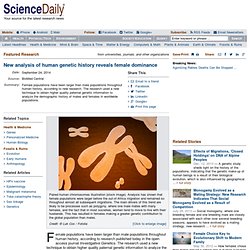

New analysis of human genetic history reveals female dominance. Female populations have been larger than male populations throughout human history, according to research published today in the open access journal Investigative Genetics.

The research used a new technique to obtain higher quality paternal genetic information to analyze the demographic history of males and females in worldwide populations. The study compared the paternally-inherited Y chromosome (NRY) with maternally inherited mitochondrial DNA (mtDNA) of 623 males from 51 populations. The analysis showed that female populations were larger before the out-of-Africa migration and remained so throughout almost all subsequent migrations.
The main drivers of this trend are likely to be processes such as polygyny, where one male mates with many females, and the fact that in most societies, women tend to move to live with their husbands. This has resulted in females making a greater genetic contribution to the global population than males. Dr. Brain Evolution: Neurogenomics Targets the Genes That Make Us Human. "I think evolutionary comparisons between species who share common ancestors are central to understanding the genome," says Michael E.

Zwick, of the Emory University Department of Human Genetics. "It's a powerful approach to identifying functionally important areas. " Beyond basic science, researchers believe that identifying genes and gene expression patterns unique to humans may illuminate how higher cognitive processes go wrong-and suggest treatments for disorders like autism and schizophrenia. The field took off about a decade ago, when the advent of gene array technology made it possible to sequence genomes of different species. Research since then has shown that humans and chimps share all but 4-5% of their DNA. Groups led by Evan Eichler and John Sikela mapped out some important specifics: several dozen duplications that distinguish us from our non-human relatives. A changed neuron "When I saw SRGAP2 mentioned on a list of human-specific duplications, I jumped on it.
News Republic. Thursday, March 13, 2014 4:52 AM GMT Wissenschaftler haben im US-Bundesstaat Alaska rund 70 Millionen Jahre alte versteinerte Überreste eines verhältnismäßig kleinen Dinosauriers entdeckt.

News Republic. Earliest footprints outside Africa discovered in Norfolk. Scientists have discovered the earliest evidence of human footprints outside of Africa, on the Norfolk Coast in the East of England.

The footprints are more than 800,000 years old and were found on the shores of Happisburgh. They are direct evidence of the earliest known humans in northern Europe. Details of the extraordinary markings have been published in the science journal Plos One. The footprints have been described as "one of the most important discoveries, if not the most important discovery that has been made on [Britain's] shores," by Dr Nick Ashton of the British Museum.
Io9. Human evolution is a “privileged” process? From The Guardian, 2004, and still of interest: Professor Lahn’s research, published this week in the journal Cell, suggests that humans evolved their cognitive abilities not owing to a few sporadic and accidental genetic mutations – as is the usual way with traits in living things – but rather from an enormous number of mutations in a short period of time, acquired though an intense selection process favouring complex cognitive abilities.

The Guardian writer, without perhaps realizing it, goes on to make Bruce Lahn’s proposed evolution sound non-Darwinian, whereas Lahn seems to want to fit it in somehow. Also: The scientists found that the human brain’s genes had gone through an intense amount of evolution in a short amount of time – a process that far outstripped the evolution of the genes of other animals. “We’ve proven that there is a big distinction,” Prof Lahn said. Lahn probably hadn’t got the memo yet about how loaded the concept of privileged is in this context. BL: Yes.
‘Habitable zones’ around stars ten times wider than we thought. Home » Astronomy, Europe » ‘Habitable zones’ around stars ten times wider than we thought The artist’s concept depicts Kepler-62f, a super-Earth-size planet in the habitable zone of a star smaller and cooler than the sun, located about 1,200 light-years from Earth in the constellation Lyra.

Life on Earth-like planets can exist at least ten times farther away from their stars than previously thought, scientists found, putting in question our whole perspective on habitable zone distances. A new paper published in the journal, Planetary and Space Science, describes how living organisms have just as much chance of surviving in areas below their uninhabitable planets’ surfaces.
This includes planets a staggering distance away from their stars, as well as even those that were recently discovered to be drifting in space by themselves, with no apparent host star. The previous commonly accepted assertion was that the so-called ‘Goldilocks’ zone was a requirement. Source GD Star Ratingloading...